Characteristics of persimmons
‘Fruit of the Gods’ Rich in vitamins A and B and containing vitamin C, persimmon trees are unique to East Asia and are native to Korea, China and Japan. Persimmons have been called the ‘fruit of the gods’ since ancient times. There is a record of the cultivation of persimmon trees in the best agricultural technology book in China, and persimmon trees are classified and listed in the Tang Dynasty’s Shinsu Boncho. They have been cultivated since ancient times in Korea and there is a record of persimmon cultivation in the Hangyang Gugeupbang.
The main component of persimmons is sugar, making up 15-16%, and they contain a lot of glucose and fructose. There are slight differences between sweet persimmons and astringent persimmons. The astringent taste component is a tannin called diospyrin, which is water soluble and easily produces an astringent taste. When acetaldehyde combines with tannins and becomes insoluble, the astringent taste disappears. The black dots inside or on the skin of sweet persimmons are the transformation of tannin cells in which the tannins are insolubilized. Persimmons are rich in vitamins A and B, and contain 30 to 50 mg of vitamin C per 100 g. The color of the fruit is due to the carotenoid pigment in the peel, and the content of lycopene, which is dark orange, is related to sunlight conditions in autumn.
The temperature conditions during the persimmon ripening period affect the quality greatly and suitable areas have an annual average temperature of 11~15°C and an average temperature of 20~23°C between September and November when the fruit ripens. In addition, because of their low tolerance for cold weather, persimmons are mainly cultivated in area south of Chungcheongnam-do in Korea.
Persimmons are divided into sweet persimmons and astringent persimmons, and sweet persimmons are not able to be cultivated in the central and northern regions. Persimmons are mainly eaten raw, and dried persimmons are produced by drying after processing such as peeling the skin and gunsi. Hongsi and yeonsi are persimmons become soft when ripened.
Kinds of persimmons
-
Sagoksi
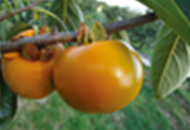 The fruit is spindle shapes and the quality is very good. There are usually no seeds, but some have two or three seeds. The fruit is round and oblate, slightly concave on top, and somewhat square. It has a strong sweet taste and is native to Sagok-myeon, Uiseong-gun, Gyeongsangbuk-do. It is the main variety of astringent persimmon.
The fruit is spindle shapes and the quality is very good. There are usually no seeds, but some have two or three seeds. The fruit is round and oblate, slightly concave on top, and somewhat square. It has a strong sweet taste and is native to Sagok-myeon, Uiseong-gun, Gyeongsangbuk-do. It is the main variety of astringent persimmon. -
Bansi
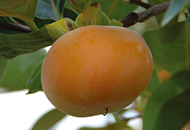 The shape is round and oblate, slightly concave on top, and somewhat pentagonal, and the quality is good. It is an astringent persimmon and used to make dried persimmons or hongsi. Cheongdo bansi are famous for being seedless.
The shape is round and oblate, slightly concave on top, and somewhat pentagonal, and the quality is good. It is an astringent persimmon and used to make dried persimmons or hongsi. Cheongdo bansi are famous for being seedless. -
Sangjudoongsi
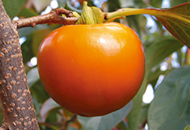 Presumed to have been first cultivated in Oenam-myeon, Naeseo-myeon, and Yeonwon-dong in Sangju-si, Gyeongsangbuk-do, doongsi is a compound word of ‘doong’ meaning ‘round’ and ‘si’ meaning persimmon tree in Chinese characters. The name comes from the round shape of the fruit. It is mainly cultivated as a variety for dried persimmons.
Presumed to have been first cultivated in Oenam-myeon, Naeseo-myeon, and Yeonwon-dong in Sangju-si, Gyeongsangbuk-do, doongsi is a compound word of ‘doong’ meaning ‘round’ and ‘si’ meaning persimmon tree in Chinese characters. The name comes from the round shape of the fruit. It is mainly cultivated as a variety for dried persimmons. -
Hamansusi
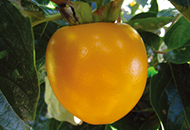 Also called ‘hamanmulgam,’ Haman-gun, Gyeongsangnam-do, is the main production area. It is widely distributed in Pasu-ri, Haman-myeon, Haman-gun, Gangyeong-ri, Gaya-eup, and Hyeongjeong-ri, Daeui-myeon, Uiryeong-gun. The color of the fruit is clear and vivid. With a high sugar content, it is excellent for dried persimmons.
Also called ‘hamanmulgam,’ Haman-gun, Gyeongsangnam-do, is the main production area. It is widely distributed in Pasu-ri, Haman-myeon, Haman-gun, Gangyeong-ri, Gaya-eup, and Hyeongjeong-ri, Daeui-myeon, Uiryeong-gun. The color of the fruit is clear and vivid. With a high sugar content, it is excellent for dried persimmons. -
Buyu
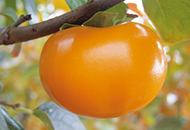 The size of the fruit is usually 210~220 g, and the shape is round and oblate, with a round tip and a light rib. It is a sweet persimmon, and the astringent taste disappears early so people can eat it in late September.
The size of the fruit is usually 210~220 g, and the shape is round and oblate, with a round tip and a light rib. It is a sweet persimmon, and the astringent taste disappears early so people can eat it in late September. -
Sangseojoseng
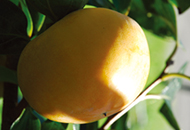 The size of the fruit is usually about 220~ 260 g, and the shape is slightly round and oblate.
The size of the fruit is usually about 220~ 260 g, and the shape is slightly round and oblate.
It is a sweet persimmon, and the taste is similar to buyu. It is harvested in mid-October. -
Charang
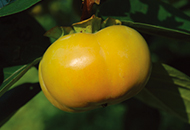 It is a sweet persimmon. The fruit is flat and the weight is about 220 ~ 250 g. The sweetness is high and the flesh is firm.
It is a sweet persimmon. The fruit is flat and the weight is about 220 ~ 250 g. The sweetness is high and the flesh is firm. -
Seochonjoseng
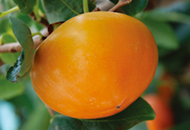 It is an incompletely sweet persimmon. The flesh is orange-yellow and hard, and it has little juice. The sugar content is not high.
It is an incompletely sweet persimmon. The flesh is orange-yellow and hard, and it has little juice. The sugar content is not high. -
Gabjubakmok
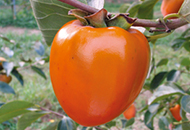 It is widely cultivated for raw persimmons and dried persimmons. The weight of the fruit is about 300 g, the sugar content is high, and the skin is thin, so the quality is good. It is harvested from late October to early November, and is suitable for cultivation in central and southern regions.
It is widely cultivated for raw persimmons and dried persimmons. The weight of the fruit is about 300 g, the sugar content is high, and the skin is thin, so the quality is good. It is harvested from late October to early November, and is suitable for cultivation in central and southern regions.
Nutritional Composition of Persimmons
Persimmons are about 15-18% sugar, mainly glucose and fructose, and they have less water than other fruits. They contain a lot of vitamins A and C. The pigment of persimmon is composed of a mixture of carotenoid pigments such as carotene and lycopene.
The astringent taste of persimmons is due to a tannin called diospyrin, which is present in the tannin cells scattered throughout the fruit. It gives an astringent taste, as the membrane of the tannin cell is weak and easily torn, and the tannin is water-soluble.
Persimmon leaves contain much more vitamin C than fruits such as strawberries and tangerines. This is actually a vitamin C precursor, and is not easily destroyed when exposed to heat, water, or air like general vitamin C.
n addition, persimmon leaves contain a component called rutin, which helps to stop bleeding and improve blood pressure. Among the components of persimmon stems, hemicellulose causes coagulation and physical stimulation, so it is presumed to be the causative substance that stops hiccups.
Persimmons in Donguibogam
Eating hongsi is advised for sore throats or thirst and eating dried persimmons for a weak stomach or indigestion. Since persimmons and persimmon leaves have many ingredients that are very beneficial to health, they are useful for preventing and treating adult diseases such as diabetes and cardiovascular diseases such as high blood pressure and make a good healthy food for the elderly when eaten often as raw fruit or porridge, or drunk as persimmon leaf tea .
Persimmons are considered a cold food, so people with cold stomachs are advised not to eat a lot. Eating dried persimmons as porridge is a good way to relieve cold energy. They are not good for people with anemia or low blood pressure, because persimmon tannins bind to iron and hinder its absorption.
Effect of persimmons (dried persimmons)
-
Persimmons have been used not only for food but also for medicinal purposes since ancient times, and they are a repository of vitamins and minerals that are essential for modern people who suffer from tiredness from fatigue.
- (Vitamin) hey are rich in Vitamin C and A, similar to fruits such as apples, pears, and tangerines that are common in autumn and winter
- (Dietary fiber) They are effective in protecting against heart diseases such as arteriosclerosis and coronary artery disease because they contains many soluble fibers such as pectin and insoluble fibers such as cellulose.
- (Citric acid)Also called ‘clear urine,’ it cleans the urine and helps strengthen muscle elasticity.
- (Tannin)Components that give an astringent taste, such as flavonoids and catechins, they also remove active oxygen in the body.
- (Zeaxanthin)A natural yellow pigment that is widely used as a natural food coloring.
- (Others) Persimmons also contain a lot of lycopene and lutein.
-
Dried persimmons contain less water than sweet persimmons or soft persimmons, and have the highest levels of sugar and all minerals.
- The main components of dried persimmons are water (32%), protein (6.3%), fat (0.44%), carbohydrates (44.8%), fiber (15%), and ash (1.99%).
- They are higher in calories and vitamin A than sweet persimmons or soft persimmons and lower in vitamin C.
Changes in taste and nutrition of dried persimmons during the drying process
-
There were three reasons that dried persimmons were made by peeling and drying for about two months. The first was to remove the astringent taste, and the second was to increase the nutrients and the third was so they could be consumed for a long period of time.
The astringent taste of persimmons occurs as a result of substances called tannins that strongly bind to a protein present in the mucous membranes of the tongue and mouth, which causes the feeling of the taste buds being squeezed.
It can be seen that the dried persimmon manufacturing method has been passed down since the Joseon Dynasty through the description of the dried persimmon processing technology in *Imwonsibyukji, an agricultural journal of the Joseon Dynasty..Dried persimmons differ from astringent persimmons not only in taste but also in nutrients. According to the results of an analysis of the nutritional value of dried persimmons, the energy of astringent persimmons is 56 kcal, while that of dried persimmons is 237 kcal, and the sugar content of astringent persimmons is 14.8 g, while the sugar content of dried persimmons is increase to 63.2 g. In the case of vitamins, it can be confirmed that the vitamin A of dried persimmons is 1.9 times higher than that of astringent persimmons, and it can be confirmed that the nutrients and vitamins change through the process of manufacturing dried persimmons.
<Dried persimmon manufacturing method in Imwonsibyukji>
[Reference]
Dried persimmon manufacturing method in Imwonsibyukji
- Peel a large persimmon and press it flat and expose it to sunlight during the day and dew at night. When it is dry, put it in a jar and take it out when a white powder has formed.
- Today, people call this sibyung (柿餠, dried persimmon) or shihwa (柿化), and the white powder on the outside is called shisang (柿霜). *Source: Korea Traditional Knowledge Portal





